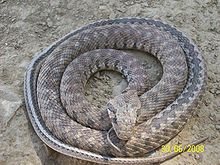Hemorrhois ravergieri
| Hemorrhois ravergieri | |
|---|---|

| |
| Scientific classification | |
| Domain: | Eukaryota |
| Kingdom: | Animalia |
| Phylum: | Chordata |
| Class: | Reptilia |
| Order: | Squamata |
| Suborder: | Serpentes |
| Family: | Colubridae |
| Genus: | Hemorrhois |
| Species: | H. ravergieri |
| Binomial name | |
| Hemorrhois ravergieri (Ménétries, 1832) | |
| Synonyms[2][3] | |
Hemorrhois ravergieri, commonly called the spotted whip snake, is a species of aglyphous (non-venomous) ophidian snake in the family Colubridae. It is endemic to Western, Central and South-Central Asia, from Turkey in the west to Kazakhstan and western Mongolia in the east.[4]
Etymology
The specific name, ravergieri, is in honor of a certain Mr. Ravergier who was an attaché at the French embassy in Saint Petersburg, Russia.[5]
Geographic range
H. ravergieri is found in the following localities.
The former Soviet republics of the Caucasus and Central Asia, the latter from the eastern shore of the Caspian Sea east to E Kazakhstan:
- Caucasus: parts of Russia, Armenia, Georgia, Azerbaijan
- Central Asia: Kazakhstan, Turkmenistan, Uzbekistan, Tajikistan
- South Asia: Afghanistan, Pakistan
- East Asia: W Mongolia, NW China (Xinjiang)
Description
Dorsally, H. ravergieri is tan or grayish, with a series of dark rhomboidal spots or crossbars, alternating with smaller spots on the sides. The spots usually become confluent posteriorly, and appear as dark stripes on the tail. There is a diagonal dark streak below the eye, and a similar subparallel streak from the back of the eye to the corner of the mouth. Ventrally, it is whitish or covered with blackish dots.
The weakly keeled dorsal scales are arranged in 21 rows. The ventrals, which are obtusely angulate laterally, number 190-222; the anal is divided; and the subcaudals, which are paired, are 75–101.
Adults may attain 133 cm (4 ft 4 in) in total length, with a tail 32 cm (12+1⁄2 in) long.[2]


References
- Citations
- ^ Disi, A.M.; Hraoui-Bloquet, S.; Sadek, R.; Werner, Y.L.; Böhme, W.; Lymberakis, P.; Tok, V.; Ugurtas, I.H.; Sevinç, M.; Crochet, P.-A.; Li, P.; Lau, M.; Borkin, L.; Milto, K.; Golynsky, E.; Rustamov, A; Munkhbayar, K.; Nuridjanov, D.; Shestapol, A.; Dujsebayeva, T. (2017). "Hemorrhois ravergieri". IUCN Red List of Threatened Species. 2017: e.T157285A749241. doi:10.2305/IUCN.UK.2017-2.RLTS.T157285A749241.en. Retrieved 21 February 2022.
- ^ a b Boulenger GA (1893). Catalogue of the Snakes in the British Museum (Natural History). Volume I., Containing the Families ... Colubridæ Aglyphæ, part. London: Trustees of the British Museum (Natural History). (Taylor and Francis, printers). xiii + 448 pp. + Plates I-XXVIII. (Zamenis ravergieri, pp. 405–406). doi:10.5962/bhl.title.8316
- ^ "Hemorrhois ravergieri". The Reptile Database. www.reptile-database.org.
- ^ "Observations • iNaturalist". 26 July 2024.
- ^ Beolens, Bo; Watkins, Michael; Grayson, Michael (2011). The Eponym Dictionary of Reptiles. Baltimore: Johns Hopkins University Press. xiii + 296 pp. ISBN 978-1-4214-0135-5. (Hemorrhois ravergieri, p. 218).
- Bibliography
- Böhme W (1993). "Coluber ravergieri - Ravergiers Zornnatter ". In: Böhme W (editor) (1993). Handbuch der Reptilien und Amphibien Europas, Band 3/I., Schlangen (Serpentes) I. Wiesbaden: Aula-Verlag. pp. 145–154. (in German).
- Ménétries E (1832). Catalogue raisonné des objets de zoologie recueillis dans un voyage au caucase et jusqu'aux frontières actuelles de la Perse. Saint Petersburg, Russia: L'Académie Impériale des Sciences. 330 pp. (Coluber ravergieri, new species, pp. 69–70). (in French). doi:10.5962/bhl.title.63878
- Schätti B, Monsch P (2004). "Systematics and phylogenetic relationships of Whip snakes (Hierophis Fitzinger) and Zamenis andreana Werner 1917 (Reptilia: Squamata: Colubrinae)". Rev. Suisse Zool. 111 (2): 239–256. doi:10.5962/BHL.PART.80237
- Schweiger M (1991). "Coluber ravergieri Menetries, 1832 - eine ungewöhnliche Zornnatter. Teil 1: Beschreibung, Verbreitung, Ökologie und Giftwirkung". Herpetofauna 13 (70): 30–34. (in German).

